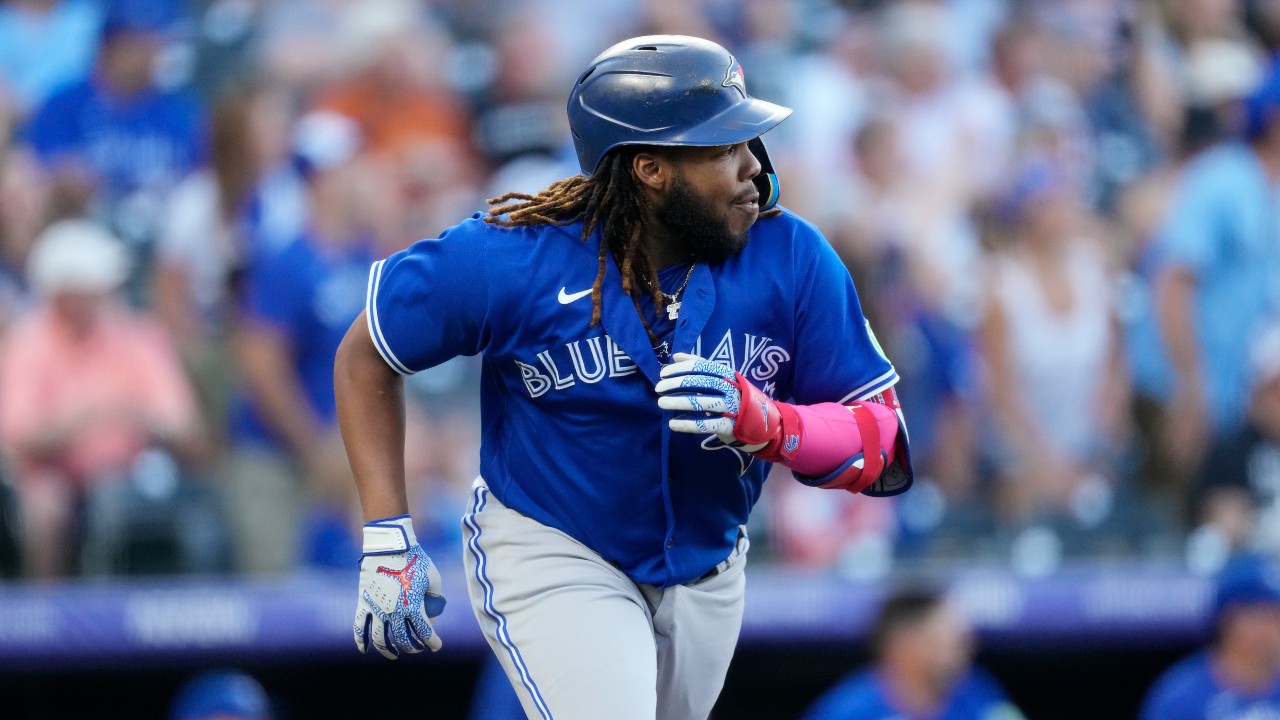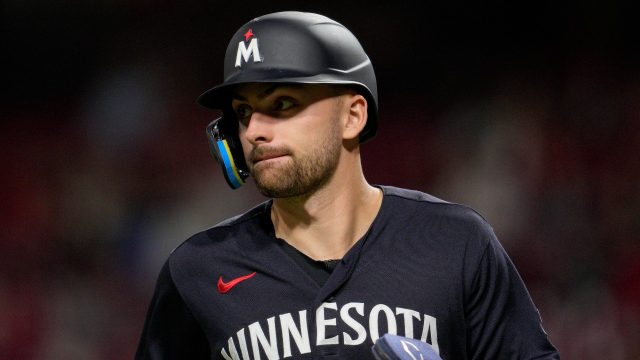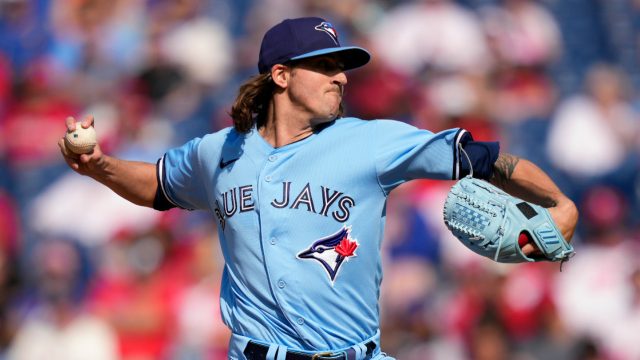
MINNEAPOLIS – One team will shed some baggage in this wild-card series, the Toronto Blue Jays with the frustrations of their wonky 2023 and burden of last year’s post-season collapse against the Seattle Mariners, or the Minnesota Twins and their 18 consecutive playoff losses.
The other, of course, will only get mired deeper in the muck, so which one is able to seize the opportunity in an American League with no obvious favourite is among the intriguing subplots that will play out at Target Field.
There is a freedom in flipping narratives or exorcising demons — however you want to describe it — that both clubs are seeking as they seek to max out their abilities this October.
“Every year is a new year, so this is obviously going to be a lot different than years past,” said Blue Jays shortstop Bo Bichette, who at 25 has already been through the pandemic-season sweep by the Tampa Bay Rays, the one-game-short heartbreak of 2021 and the sweep by the Mariners last year. “But we think we’re better than what we’ve shown. So I think that’s motivation to show that.”
Said Twins president of baseball operations Derek Falvey, unfairly burdened by a streak that dates back to 2004 and is mostly the product of others: “We’ve talked about this in this stadium, this environment for a while. We know that. Our guys know that. They are aware of the history of this organization. I will tell you that the vast majority of the players in that room have not been a part of that over the course of that time. But they focus on what they can control, which is the game right in front of them. That’s been a hallmark of this team all year.”
A boost for the Twins should come with shortstop Carlos Correa (plantar fasciitis) and third baseman Royce Lewis (strained hamstring) expected to play in the series, although centre-fielder Byron Buxton (strained hamstring) is not.
The Blue Jays, meanwhile, are planning to run out the same roster they finished the season with and continue to, in the words of Game 1 starter Kevin Gausman, “kind of figure out the kinks and put it all together.” Projection models continue to look favourably at their chances, with FanGraphs giving them a 57.3 per cent chance of advancing to the division series and a 5.9 per cent chance of winning the World Series, which is sixth among the 12 clubs still playing.
Despite an oft-uneven 89-73 season, that should come as no surprise, as Gausman correctly points out that “if you look at our roster, talent-wise, you can compare us to anybody in the league.”
“But talent is only going to take you so far,” he added. “We definitely haven’t necessarily played our best brand of baseball throughout 162 games. I think everyone would agree in there that there were some series and some stretches where we just didn’t play well. The underlying attitude with everybody was that (with what) we have, what we’re capable of (is) to win.”
The gap between talent and outcome, between projections and performance, has been an ongoing story since the club’s unexpectedly quick emergence into a post-season contender during the pandemic summer of 2020. A two-game sweep at Tropicana Field during those playoffs wasn’t a surprise but then the next season, despite their three-home-field odyssey, the Blue Jays squandered a roster full of peak-season players, undone by a flier-filled bullpen that easily cost them a dozen wins.
Last year, of course, the Blue Jays similarly didn’t hit their stride until late in the season to finish in the top wild-card spot, landing them what appeared to be a favourable playoff matchup against Seattle. But Luis Castillo shut them down in the first game before the still-gutting 10-9, Game 2 loss, in which they blew an 8-1 lead, ended their season, the Mariners partying on the Rogers Centre infield.
In the wake of that setback, the Blue Jays front office prioritized run prevention and lineup diversification during the off-season, with walk-year outfielders Teoscar Hernandez (Erik Swanson) and Lourdes Gurriel Jr. (with top prospect Gabriel Moreno for Daulton Varsho) traded in the turnover.
This year, they finished fourth in the majors with a 3.78 ERA, but at 746 runs, they were 14th after sitting fourth with 775 a year ago, often left frustrated following a close game in which they were a key hit short.
“We saw an opportunity to improve our defence, it wasn’t really a reaction (to the Mariners loss) as much as it was, how can we improve our team?” GM Ross Atkins said of the approach last off-season. “And that was an area on the run-prevention side. Didn’t want to subtract, if any, if possible, from what the run-production side was. Felt like we put together a really good run-scoring team. I know that has ebbed and flowed this year, but still feel really good about our chances to score runs.”
That, of course, has been an issue that’s followed the Blue Jays all season long, and the feeling of so many games slipping through their fingers has distracted from them finishing with the American League’s fifth-best record despite playing in the absurdly deep East.
Still, a constant question from industry rivals this year has been some form of, why aren’t these guys hitting, underlining the apparent trade-off the Blue Jays made last off-season and the new identity, as a pitching-first club that grinds for runs, they’ve had to adopt.
At the same time, the final month was their most productive of the year at the plate, with 143 runs in 28 games, or 5.11 per outing, largely driven by better and more timely hitting, an area that had been maddeningly inconsistent.
Atkins said “there’s no smoking gun that we can look to” as the reason the offence hasn’t rolled the way the club projected internally. “Early in the year, it was (hitting) with runners in scoring position. Then we had a little bit of a lull in power. Over the last couple of weeks, it looks like the offence that we thought we would see in spring training. Hopefully, that turns out to be the case in this series and hopefully beyond that.”
If it doesn’t, then there’s the pitching and defence to fall back on, two elements that have been stable and productive all season long for the Blue Jays, who over the past few years have learned a lot of hard lessons.
“I just think our team is prepared, and we’ve played a lot of close games all year,” said right-fielder George Springer. “And guys have learned from what happened last year and also in 2020 and, then, all throughout the season.”
What can the Blue Jays take from that?
“That anything can happen. Anything can happen, does happen,” replied Springer, who left Game 2 against the Mariners on a stretcher after a frightening collision with Bichette in shallow centre while chasing J.P. Crawford’s eighth-inning, game-tying, bases-loaded blooper. “It doesn’t matter. It’s one pitch, it’s one play, it’s one at-bat that can make the difference. Obviously for myself, yeah, it’s a play that I would have liked to make. I didn’t and that’s on me. But at the end of the day, I think our team is equipped to handle a moment like that. We’ll see what happens.”
And so, for the Blue Jays and the Twins, they get at least two games to earn the right to play more, to break free from the past, to hit their ceiling when it matters most, to have endured all they have endured and come out better for it.
“I know our defence is amazing and the pitching has been amazing. I still think that we’re a pretty good offence, too,” said Bichette. “You need to do everything well in the playoffs to win. And we look forward to seeing what we’re capable of.”







